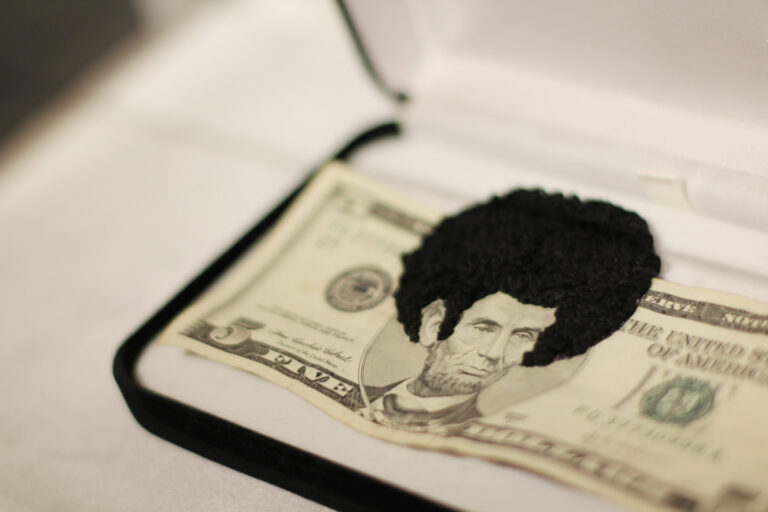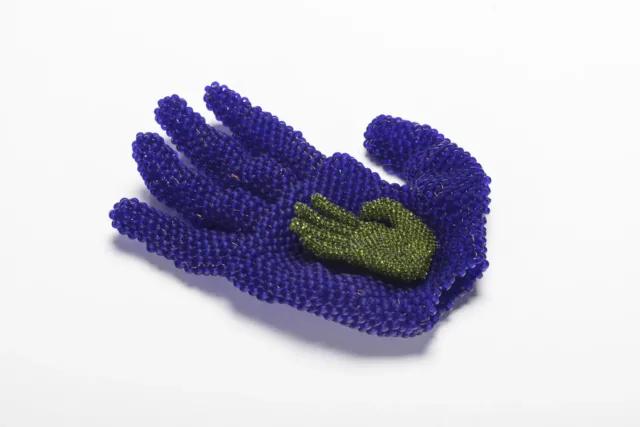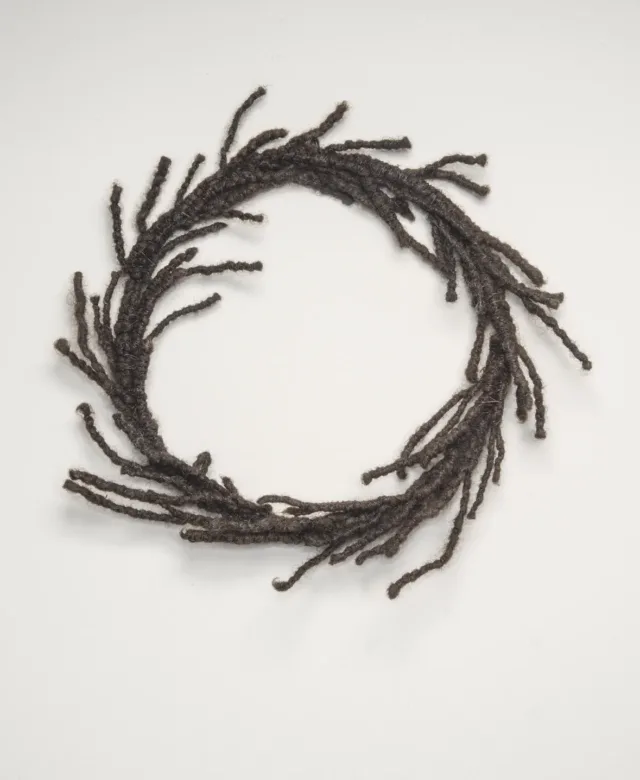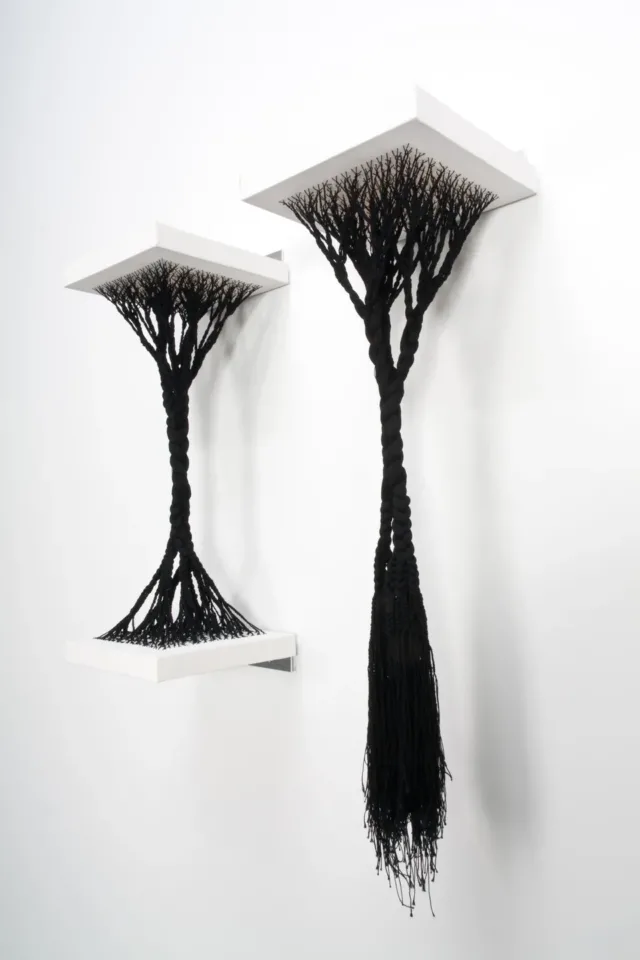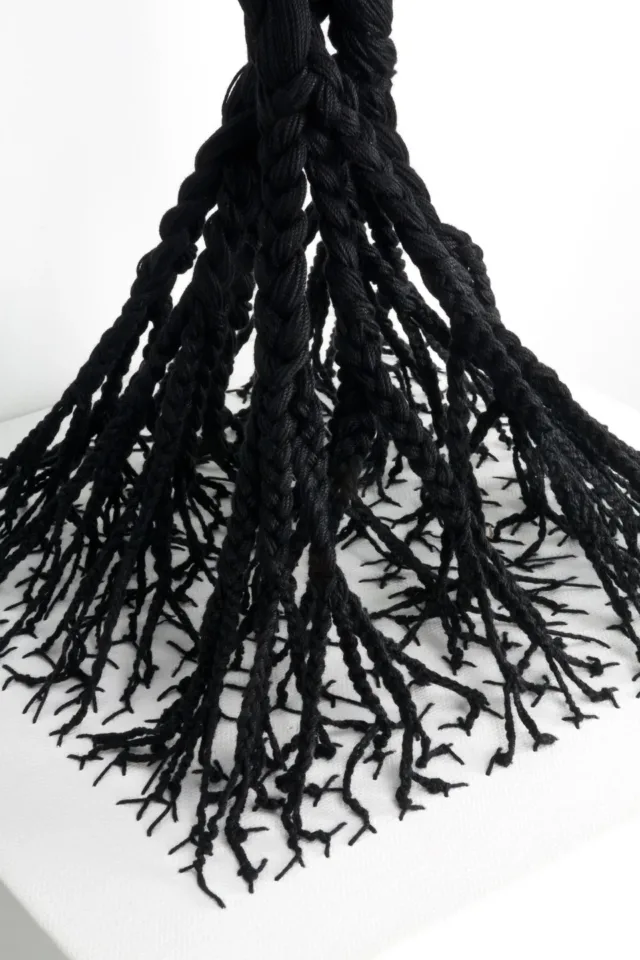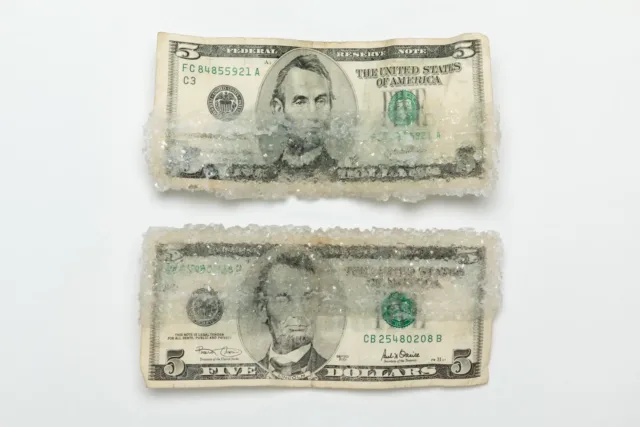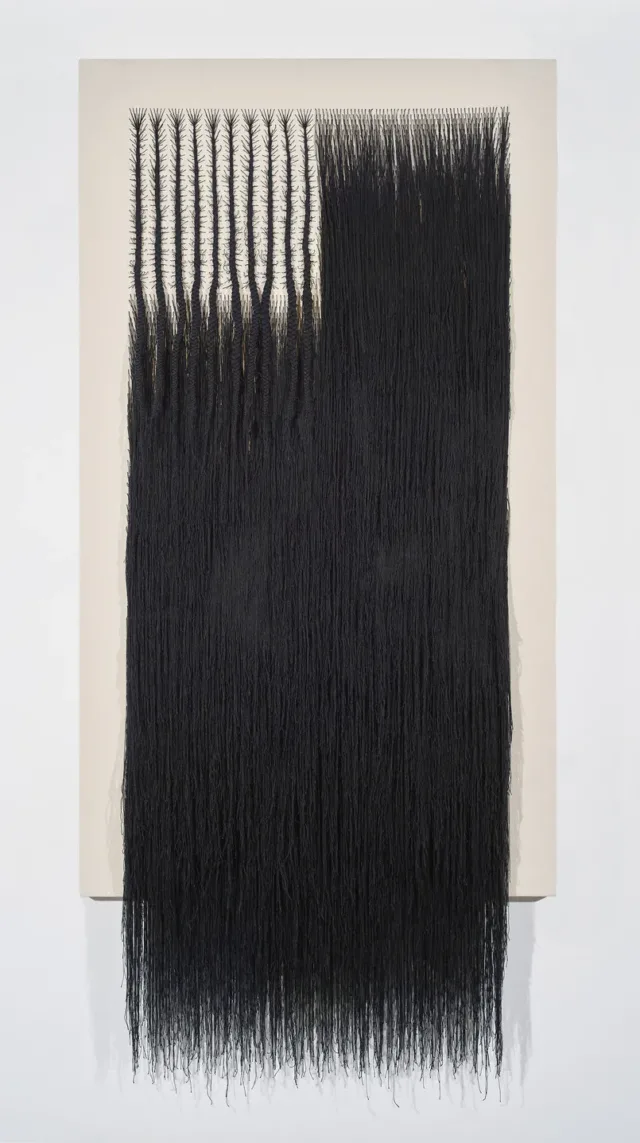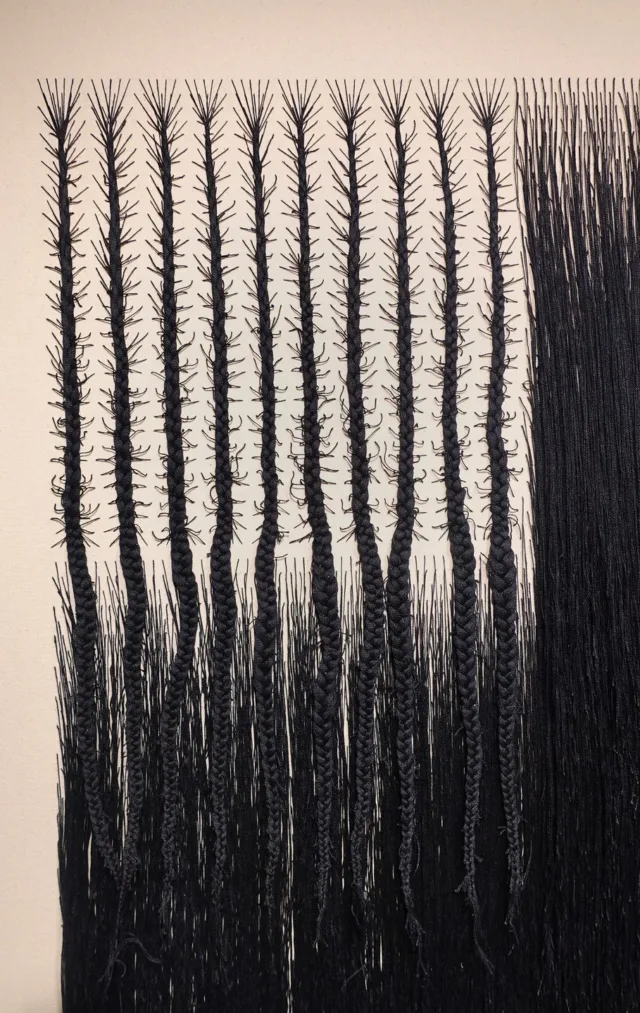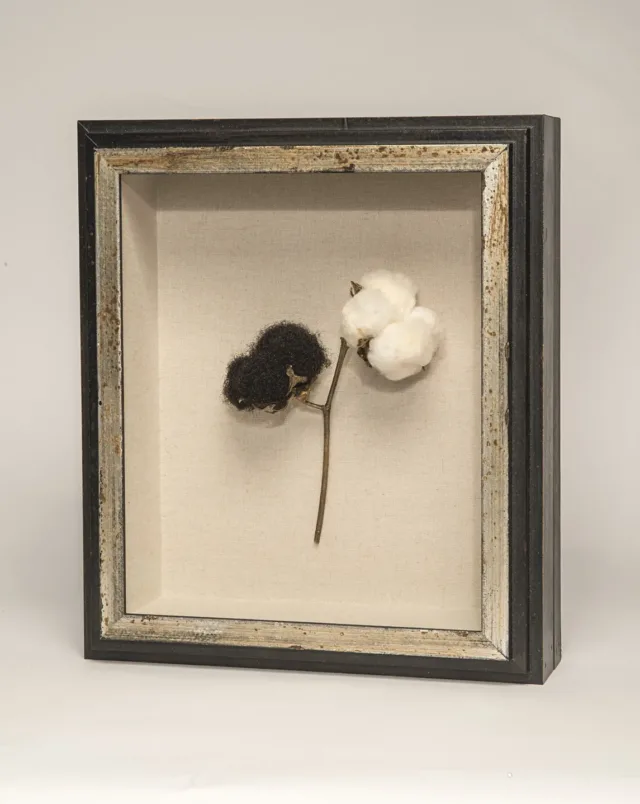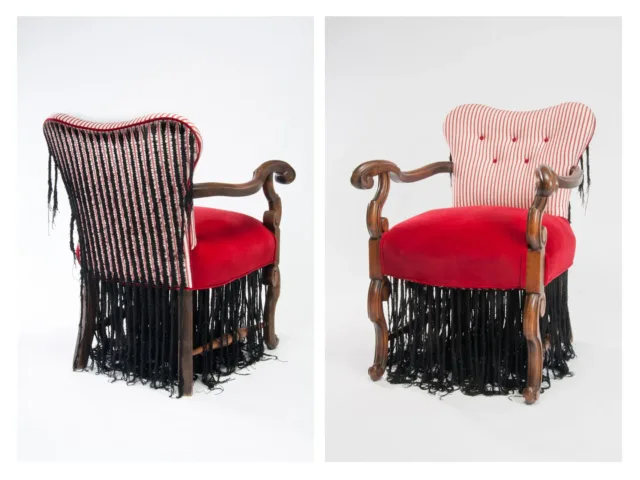To demonstrate the connection between fiber art processes and hairdressing, Clark used dark thread as a stand-in for hair in her “Wig Series.” “That which is carried on the head is often indicative of what is within the head,” she says. Twists suggest an energetic, animated state of mind, for example.
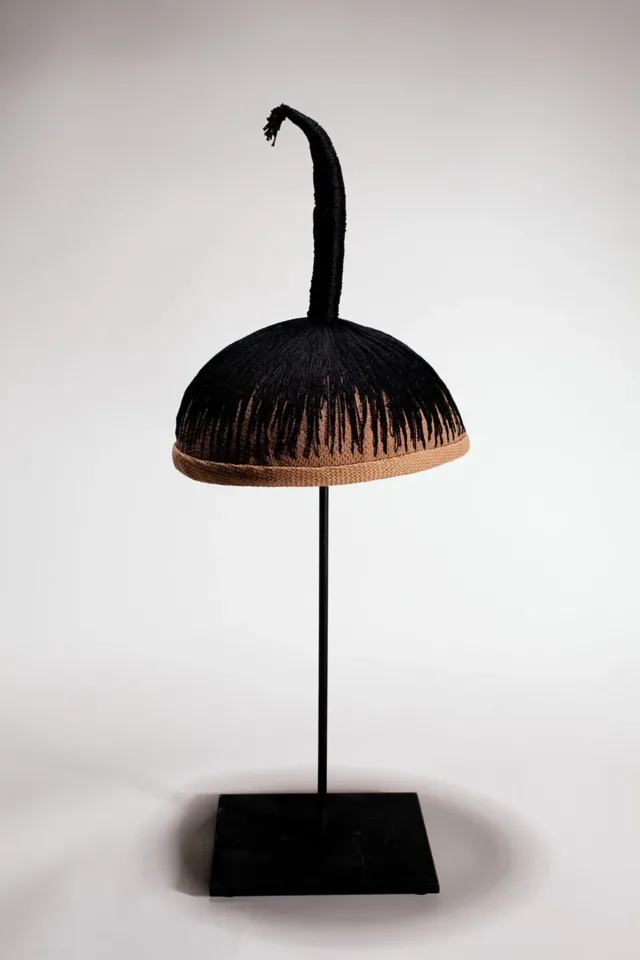
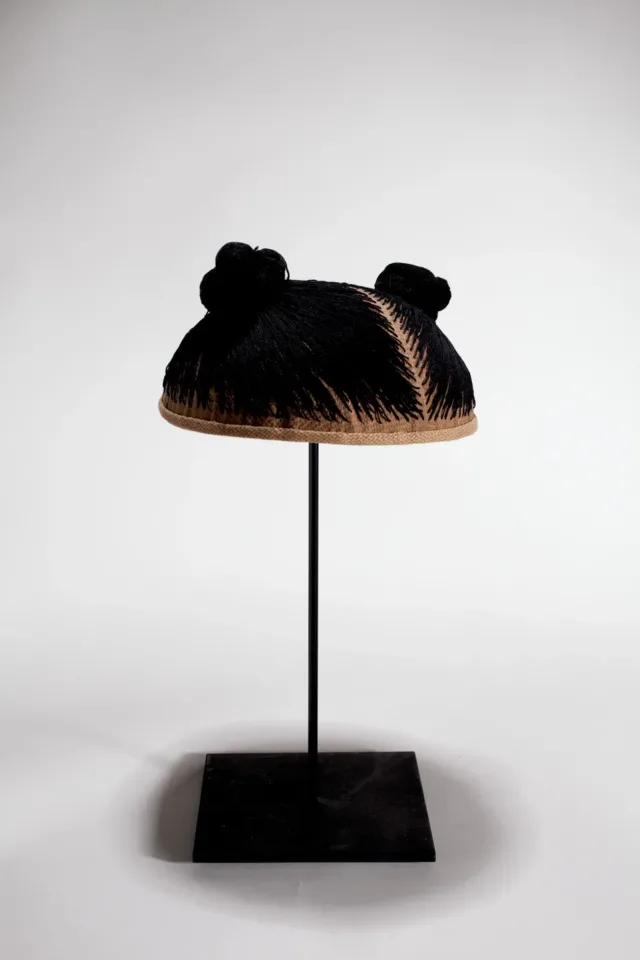
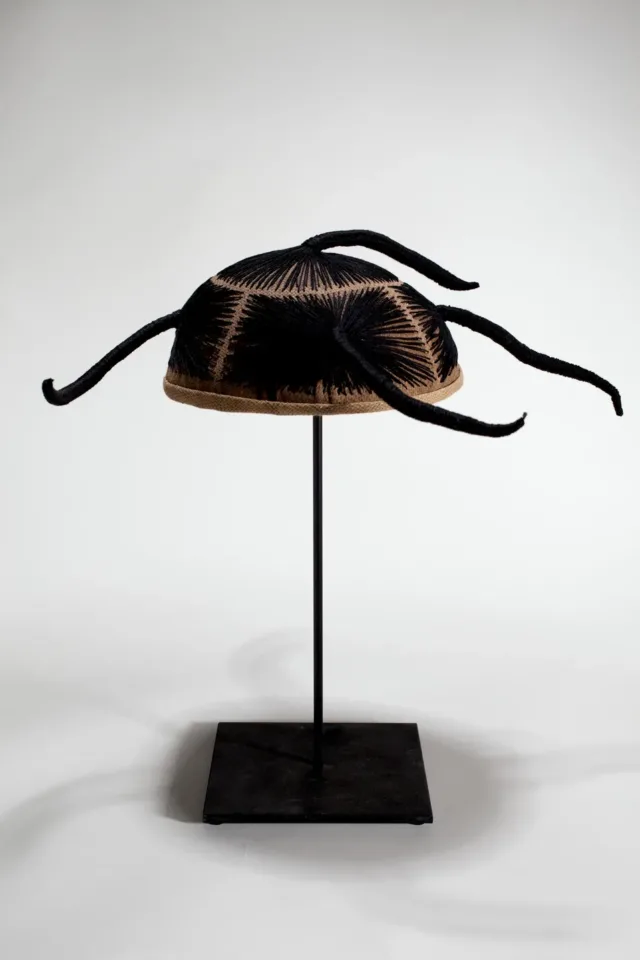
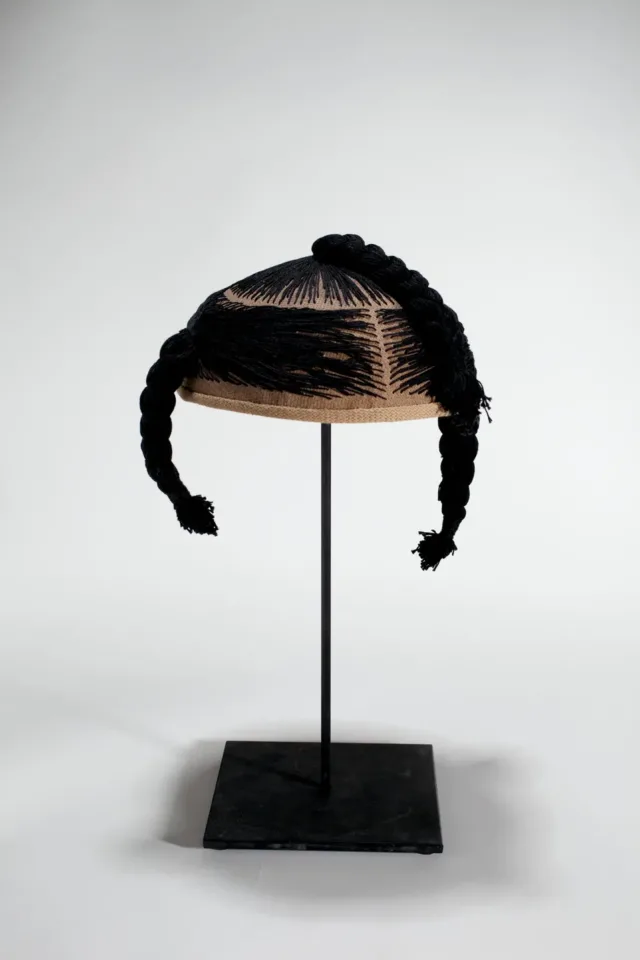
Left to right and top to bottom: Sonya Clark, Unum, Hemi, Fingers, and Triad, from the “Wig Series,” 1998; Cloth and thread, dimensions variable.; Courtesy of the Madison Museum of Contemporary Art, Purchase through the Rudolph and Louise Langer Fund; © Sonya Clark; Images courtesy of the Madison Museum of Contemporary Art
Clark’s early work includes a variety of symbolic headpieces expressive of the Yoruba concept of ashe, a divine life force sited in the head. Blued is one of a number of blue-hued headpieces the artist created that reference both Yoruba artistic traditions and the encounters between Africa and the Western world. The chain connecting these two caps makes clear reference to the slave trade that bound Africa with colonial Europe and the Americas.
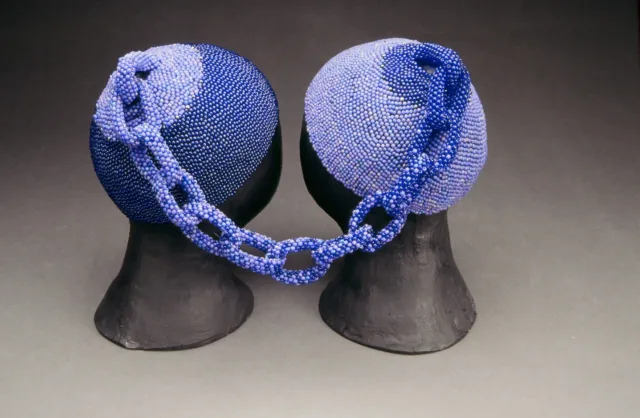
Sonya Clark, Blued, 1998; Glass beads, 9 x 14 x 9 in.; Private collection; © Sonya Clark; Photo by Tom McInvaille
Clark arranged the multicolored beads within this work to represent the genetic code for melanin, the pigment that produces color in the skin, hair, and eyes of humans. Naturally occurring genetic mutations of melanin have produced wide variations of skin color within populations since the beginning of the modern human species. Clark’s sculpture gives shape to a genetic material that has taken on a disproportionate significance in American culture and racial history.
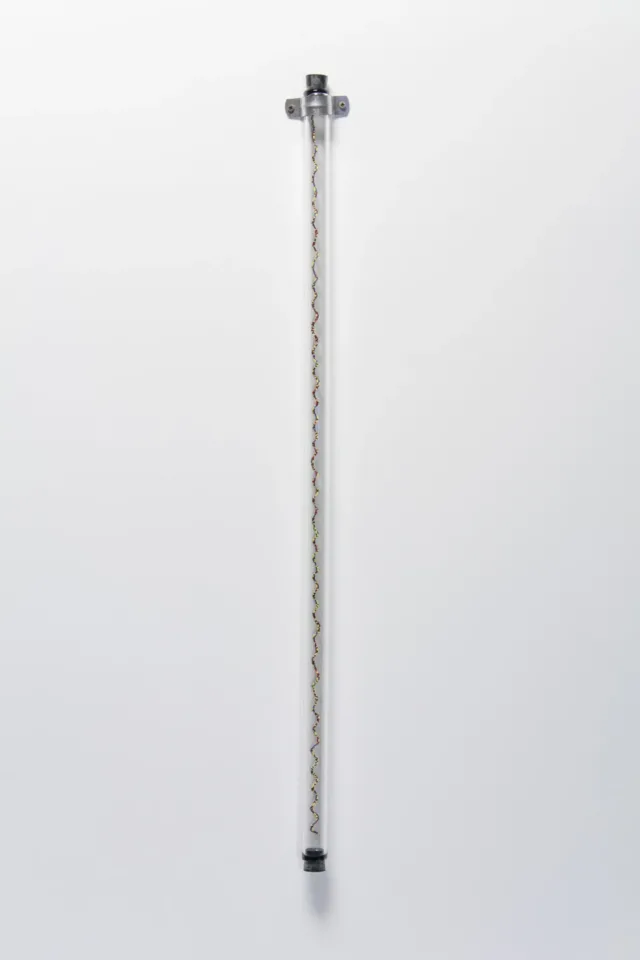
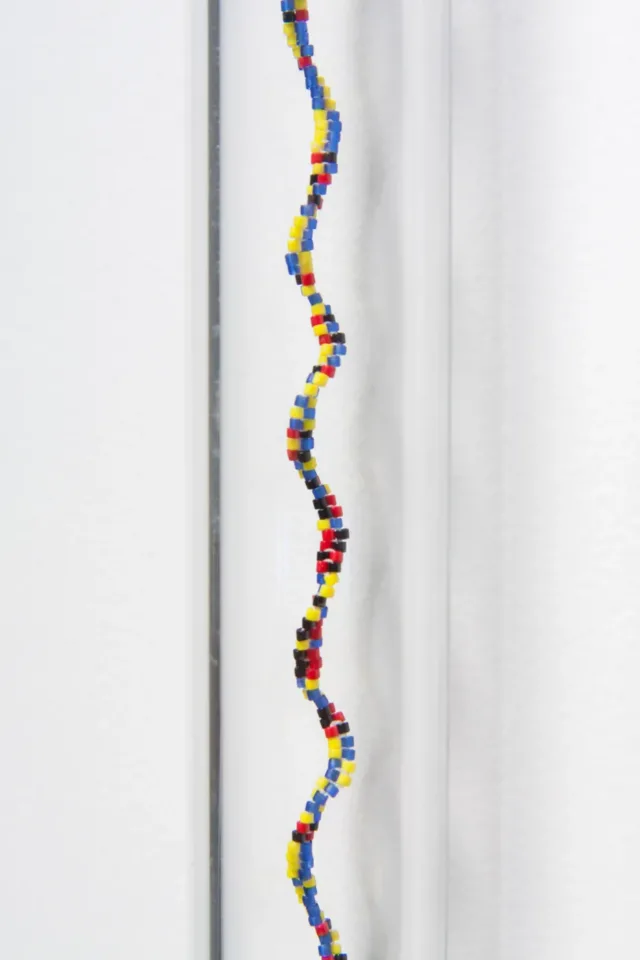
Top to bottom: Sonya Clark, Melanin (and detail), 2002; Glass tube and glass beads, 38 ¼ x 3 x 2 in.; On loan from the artist; © Sonya Clark; Photos by Taylor Dabney
Clark’s ancestors include people of the Yoruba culture in West Africa, who associate the color white with wisdom—and see white hair as an outward sign of knowledge. In this image, the artist’s hands cradle her mother’s white hair. Clark’s mother’s forebears were forced from Africa to the Caribbean as part of the slave trade that fueled the sugar industry (sugar being the main ingredient of cotton candy), which flourished in the region from the sixteenth century.
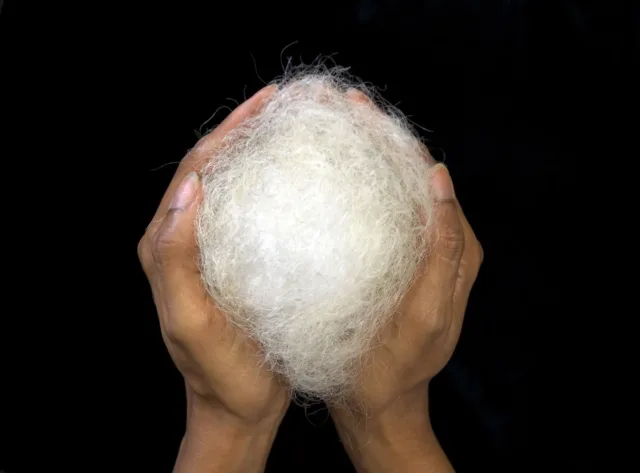
Sonya Clark, Mom’s Wisdom or Cotton Candy, 2011; Photograph, 22 ¼ x 30 in.; On loan from the artist; © Sonya Clark; Image courtesy of the artist
In some works, Clark replaces parts of common objects with her own hair—in this case, the keys of a vintage typewriter—asserting a Black presence into places where it has been pointedly omitted, such as the field of creative writing. This particular typewriter, a Remington Noiseless, was produced in the 1920s and ’30s, at the height of the Harlem Renaissance.
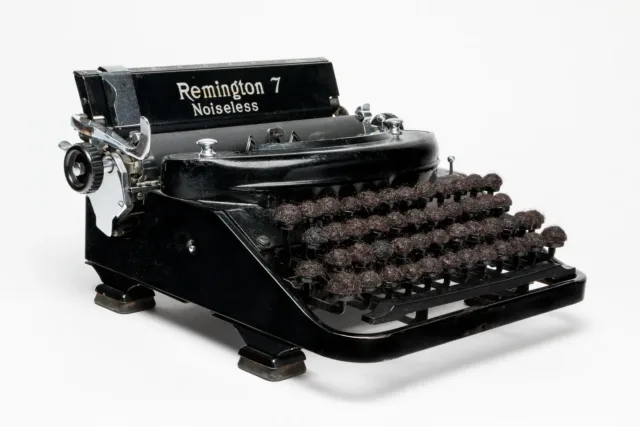
Sonya Clark, Writer Type (Pen and Sword), 2016; Remington Noiseless 7 typewriter and artist’s hair, 7 x 10 x 11 in.; On loan from the artist; © Sonya Clark; Photo by Taylor Dabney
By restringing violin bows with human hair—one with a dreadlock made from her own hair, and the other with straight, blond hair—Clark connects music and identity. With hair as a holder of DNA, the bows present the possibility of bringing ancestral voices to life. In a 2018 performance, “Sounding the Ancestors,” jazz musician Regina Carter used the bow strung with Clark’s dreadlock to play Francis Scott Key’s “The Star-Spangled Banner” and James Weldon Johnson’s “Lift Every Voice and Sing,” known as the “Black National Anthem.”
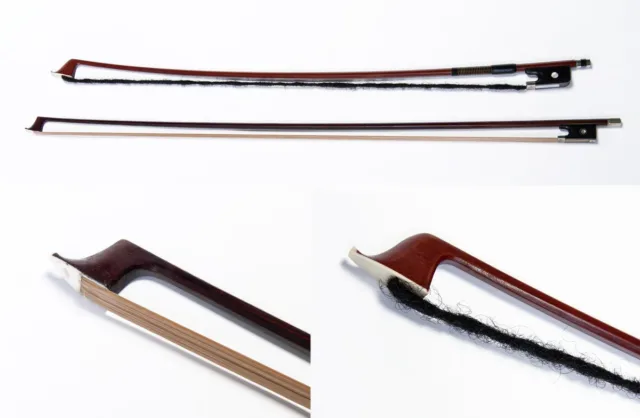
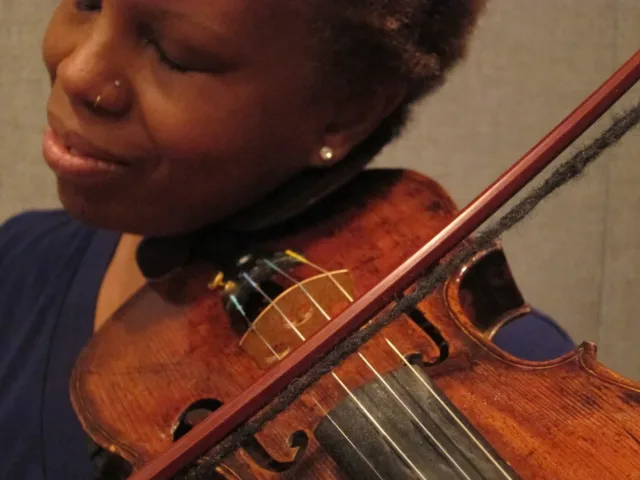
Top: Sonya Clark, Hairbows (and details), 2014; Artist’s hair, blond hair, and violin bows, each 1 x 29 x ½ in.; On loan from the artist; © Sonya Clark; Photos by Taylor Dabney; Bottom: Jazz violinist Regina Carter plays Sonya Clark’s Hairbow (2014); Photo by Alvester Garnett
More than 80,000 individual hairs come together in this dreadlocked skein, representing the approximate number of Africans forcibly migrated as chattel slaves in just one year at the height of the transatlantic slave trade. Through her work, Clark often unravels complex racial, social, and cultural issues. While this skein is tightly wound, a loose end emerges—an invitation to viewers to begin the difficult but necessary work of unwinding these issues alongside the artist.
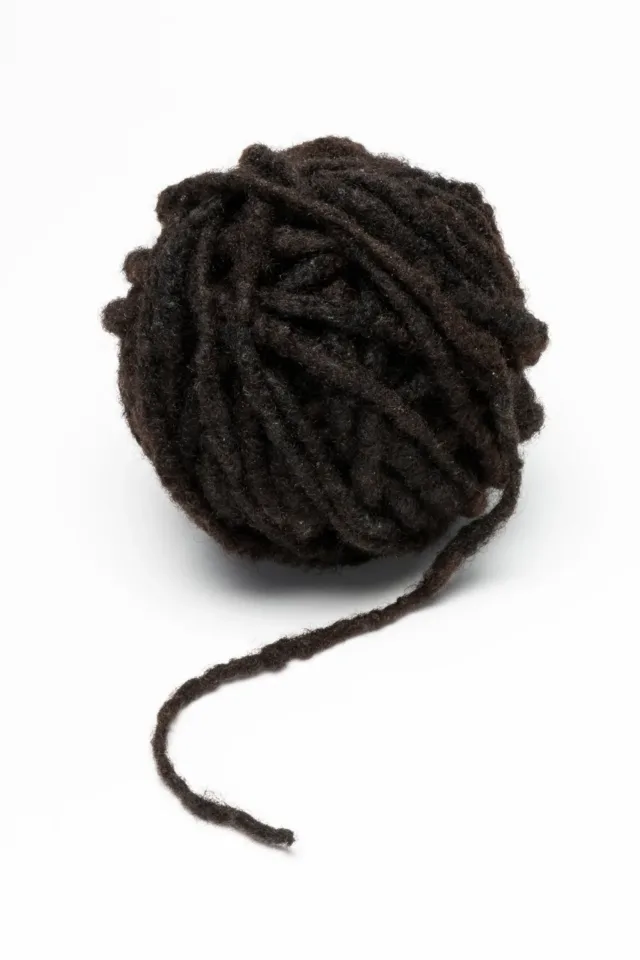
Sonya Clark, Skein, 2016; Human hair, 5 x 5 x 8 in.; On loan from the artist; © Sonya Clark; Photo by Taylor Dabney
In her Hair Necklace works, Clark rolls, twists, balls, and loops human hair to create necklaces of many styles and forms. In some families, jewelry is an heirloom, inherited through generations—much like the DNA found in hair. To craft such pieces from hair rather than gems suggests that hair itself is the heirloom, a crowning jewel comprised of the fiber of one’s ancestors.
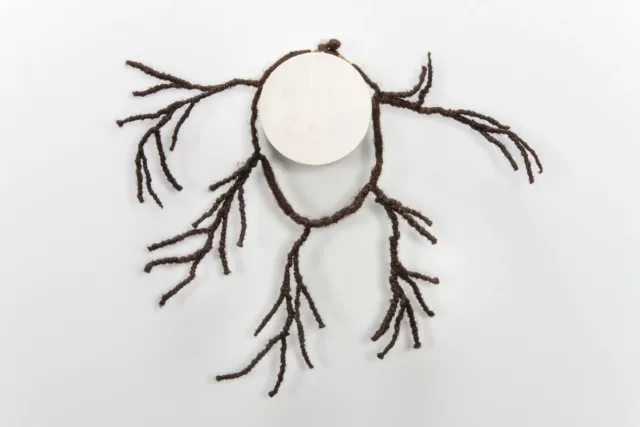
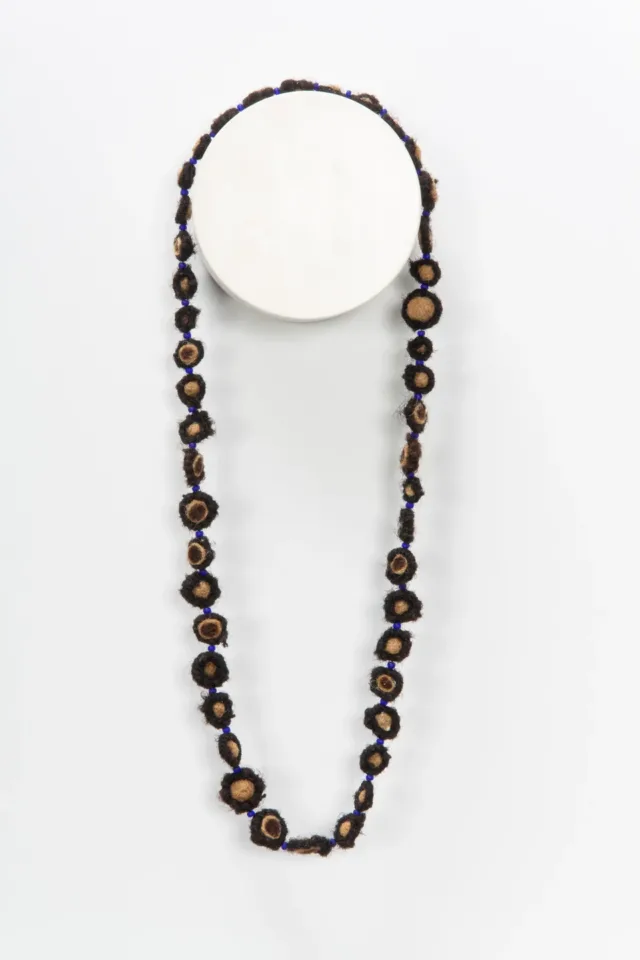
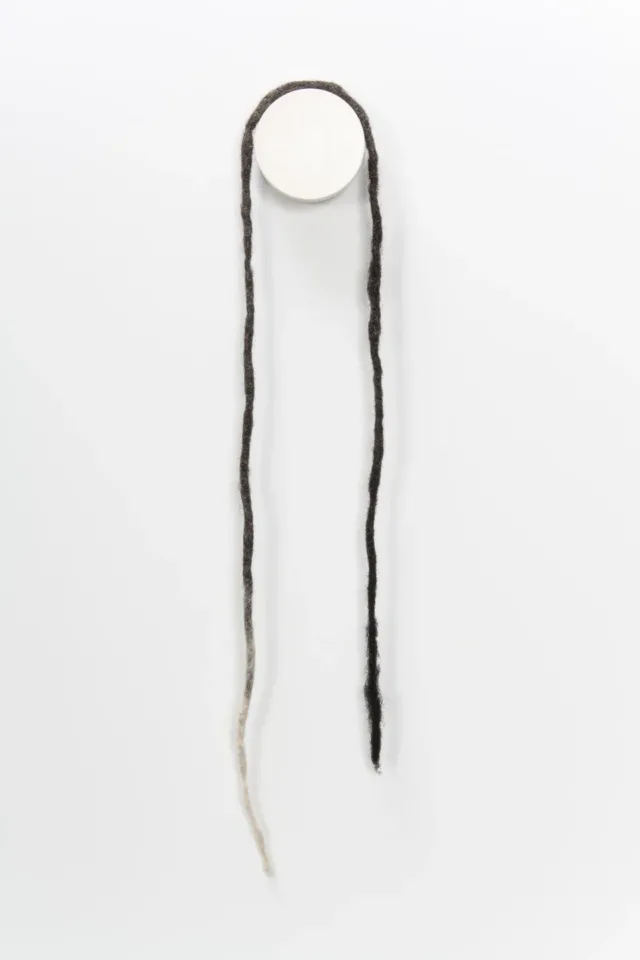
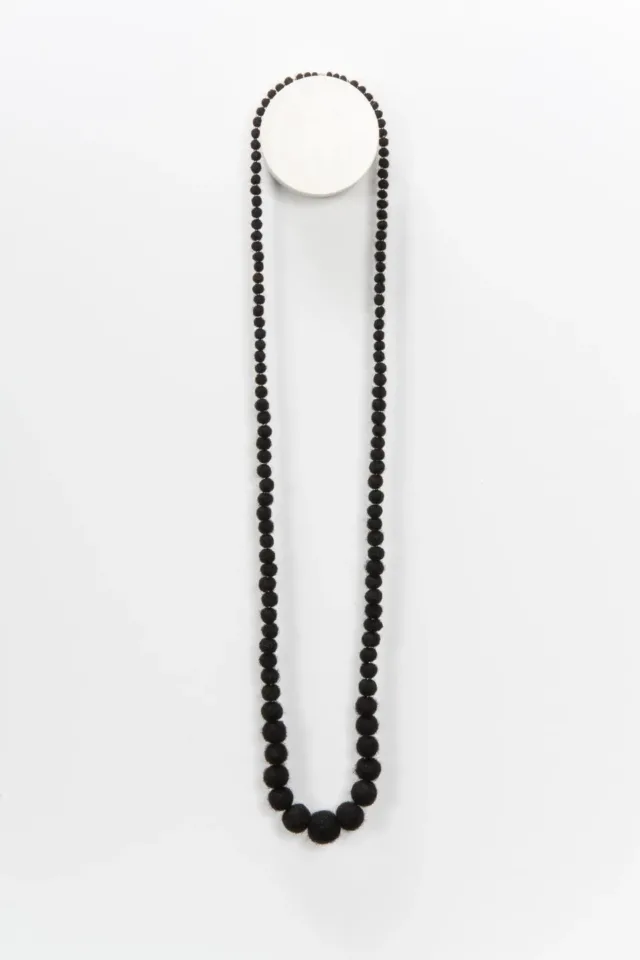
Left to right and top to bottom: Sonya Clark, Hair Necklace 5 (Branches), 2006; Human hair, 16 x 13 in.; Hair Necklace 2, 2012; Human hair and beads, 16 x 6 in.; Hair Necklace 3, 2012; Human hair, 28 x 4 in.; Hair Necklace 6 (Pearls), 2014; Human hair, 30 x 5 in.; On loan from the artist; © Sonya Clark; Photos by Taylor Dabney
Clark began this series shortly after the death of playwright Ntozake Shange in late 2018. Shange’s best-known work, the choreopoem (poem choreographed to music) for colored girls who have considered suicide/when the rainbow is enuf, premiered in 1976. Clark wrapped the spines of black combs with vivid threads, bound the combs together, and nestled each “tapestry” into an afro wig. The wrapped combs’ array of colors calls to mind the characters in Shange’s production (Lady in Green, Lady in Blue, Lady in Orange, etc.).
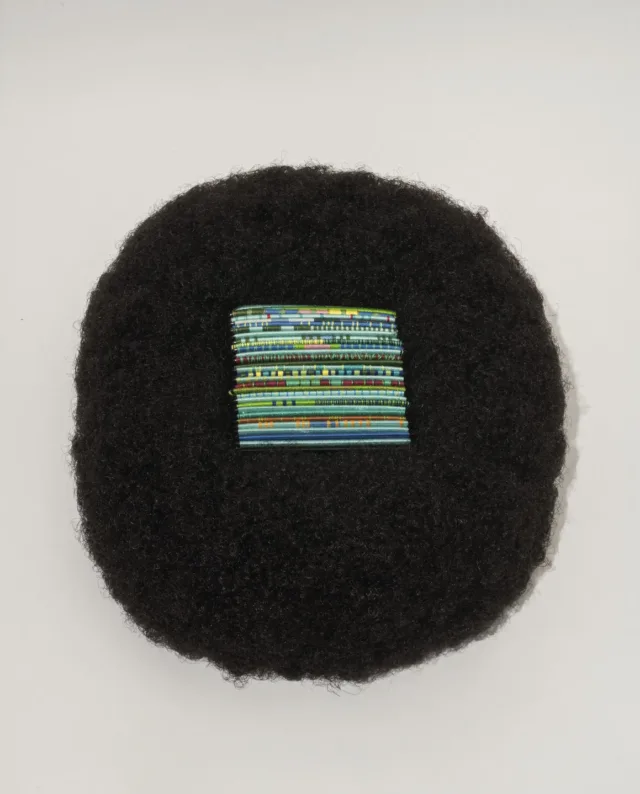
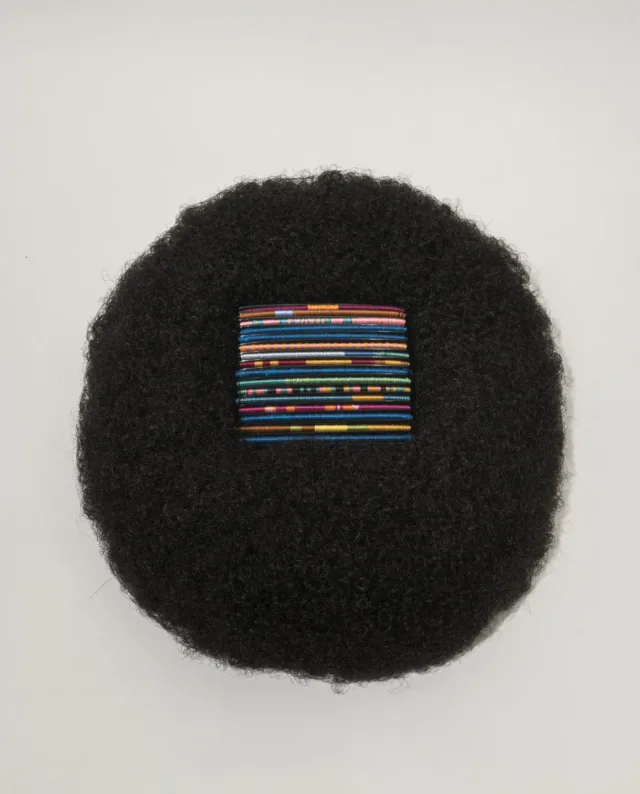
Top to bottom: Sonya Clark, For Colored Girls, A Rainbow (Green), 2019; Afro wig, plastic combs, and thread, 12 x 12 x 5 in.; and For Colored Girls, A Rainbow 1, 2019; Afro wig, plastic combs, and thread, 12 x 12 x 3 in.; On loan from the artist; © Sonya Clark; Photos by Lee Stalsworth
The term “triangle trade” describes the network of economic exchange between Europe, Africa, and the Americas in the sixteenth through nineteenth centuries. Transatlantic triangular trade routes enabled the exchange and plunder of enslaved people, cash crops, and manufactured goods. Clark’s use of cotton thread and a cornrow braid—sometimes called “canerows” in the Caribbean, for the region’s sugarcane production—reference the crops that perpetuated the cruel system.
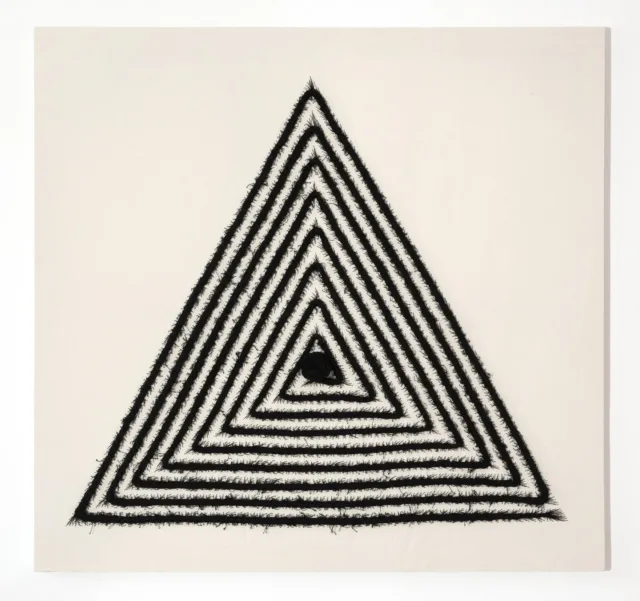
Sonya Clark, Triangle Trade, 2011; Cotton thread on canvas, 60 x 70 in.; Collection of Minnesota Museum of American Art, Purchase, Acquisition Fund, 2016.07.01; © Sonya Clark; Photo by Rik Sferra
This illuminated sculpture toggles between the word “schiavo,” the Italian word for “slave,” and “ciao,” the informal salutation that extends from an Italian phrase meaning “I am your slave.” Excavating language is one way that Clark exposes latent racism that passes through time without reflection. People around the world toss a “ciao” to friends each day, but few know that the phrase is borne of a casual reference to slavery.


Sonya Clark, Schiavo/Ciao, 2019; Neon, 10 x 50 in.; On loan from the artist; © Sonya Clark; Photos by Lee Stalsworth
5,242 inches of gold wire comprise the thread wound tightly around this hand-carved African ebony spool. The length equals the distance in miles between Cape Coast, Ghana (once known as the Gold Coast), and Richmond, Virginia, the second-largest port for human trafficking at the height of the transatlantic slave trade.
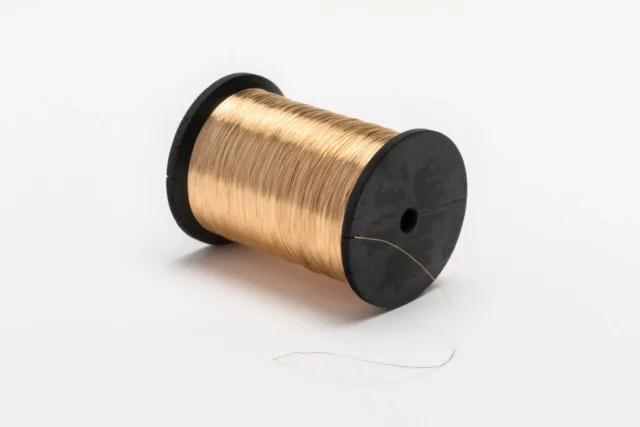
Sonya Clark, Gold Coast Journey, 2016; 18K gold wire and African ebony; 1 ¾ x 1 ¼ x 1 ¼ in.; On loan from the artist; © Sonya Clark; Photo by Taylor Dabney
Sugar replaces the traditional diamond in this pair of golden rings. This type of ring often represents a legal union through marriage. Clark uses it to illustrate the binding ties between slavery and goods such as sugar, a major cash crop of the slave trade.
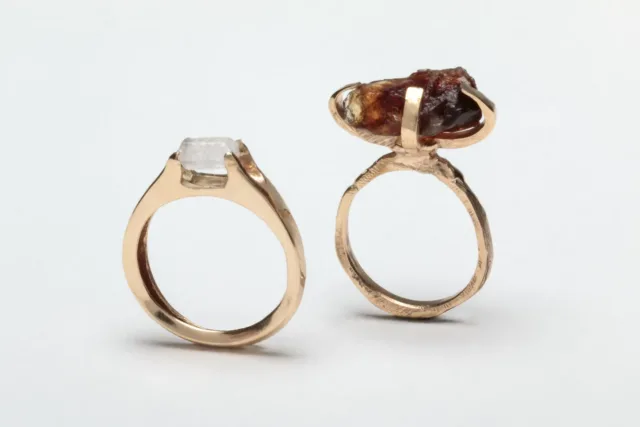
Sonya Clark, Engagement Rings, 2016; Gold and sugar, each 1 x 1 x ¼ in.; On loan from the artist; © Sonya Clark; Photo by Taylor Dabney
The handwoven strips of cloth in this textile are made with a Ghanaian weave structure known as kente. Clark plaited the strips into a composition resembling the U.S. flag. As part of a performance that brought together “both Africanness and Americanness,” Clark recalls, she asked fifty Black women to tie this cloth on their head in the form of a gele, or Nigerian head wrap, and record their thoughts about kente cloth, the American flag, and the term “African American.”
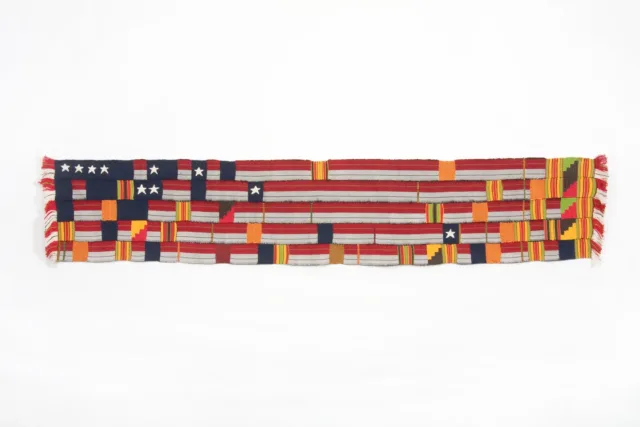
Sonya Clark, Gele Kente Flag, 1995; Handwoven silk and cotton, 15 x 72 in.; Muscarelle Museum of Art, Acquired with funds from the Board of Visitors Muscarelle Museum of Art Endowment, Muscarelle Museum of Art at William & Mary 2020.004; © Sonya Clark; Photo by Taylor Dabney
Clark developed Unraveling in 2015 – the 150th anniversary of the end of the American Civil War. She activates the work in performances, inviting viewers to stand beside her and join her in unraveling the heavy cotton flag, thread by thread. The painstaking work emblematizes “the slow and deliberate work of unraveling racial dynamics in the United States,” Clark explains. “I think there’s poetry in what we’re trying to do together.”
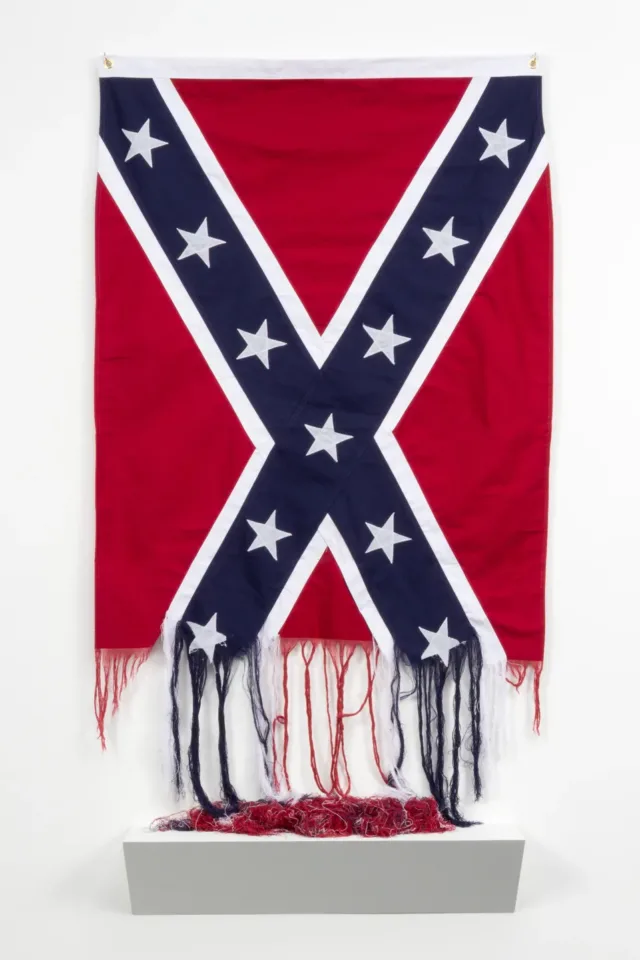
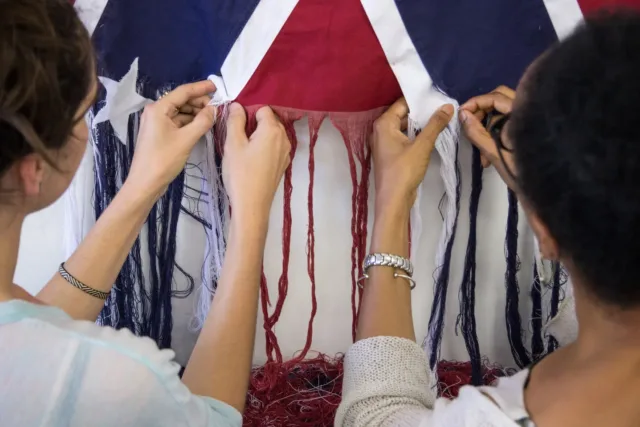
Top: Sonya Clark, Unraveling, 2015; Cotton Confederate battle flag, 70 x 36 x 7 in.; Courtesy of the artist and Lisa Sette Gallery; © Sonya Clark; Image courtesy of the artist and Lisa Sette Gallery; Bottom: Sonya Clark, Unraveling (detail, performance), 2015; Cotton Confederate battle flag, 10 x 36 x 7 in.; Courtesy of the artist and Lisa Sette Gallery; © Sonya Clark; Photo by Taylor Dabney
At the Smithsonian National Museum of American History, Clark viewed part of the Confederate flag of truce, a dish towel used by Confederate troops to surrender at Appomattox Court House, Virginia, on April 9, 1865, marking the end of the American Civil War. In Monumental Cloth (Sutured), she rewove the cloth at an enlarged scale and used black suture thread to stitch the two halves together, as if binding a wound.
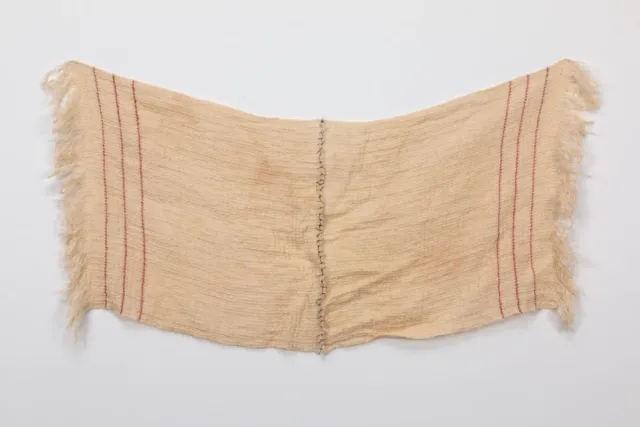
Sonya Clark, Monumental Cloth (Sutured), 2017; Linen replica Confederate truce flag and silk thread, 18 x 36 in.; On loan from the artist; © Sonya Clark; Photo by Taylor Dabney
“Everyone knows the Confederate battle flag. After seeing the truce flag . . . I realized it wasn’t hidden, but it also wasn’t elevated,” Clark says. Here, she rewove a fragment of the towel, which she describes as “the flag we should all know,” at 10:1 scale, magnifying its significance.
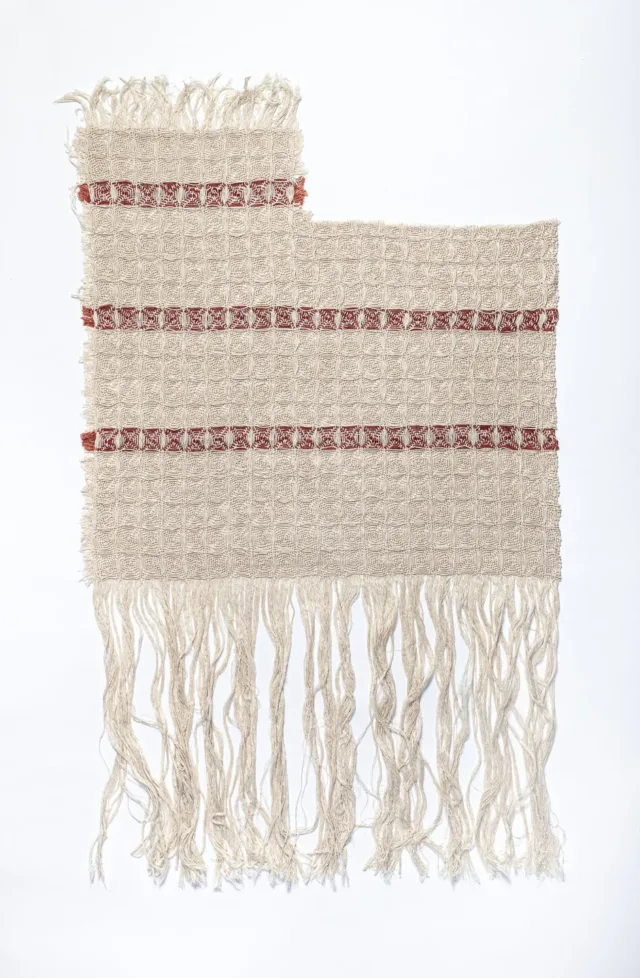
Sonya Clark, Monumental Fragment, 2019; Linen, 50 x 34 in.; On loan from the artist; © Sonya Clark; Photo by Taylor Dabney
Just before Barack Obama became President of the United States, Clark embroidered her first afro onto the head of Abraham Lincoln on a five-dollar bill. Her needlework on legal tender invokes the promise of Black social and political agency. Regarding the new hairstyle she gave to President Lincoln, Clark says, “First, Lincoln looks much better with an afro. Second, it’s crowning the Emancipator with the hair most associated with Black liberation and Black power.”
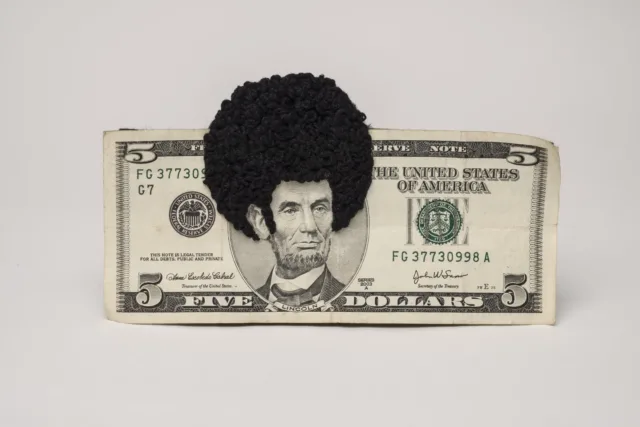
Sonya Clark, Afro Abe II, 2010; Five-dollar bill and thread, 4 x 6 in.; National Museum of Women in the Arts, Gift of Heather and Tony Podesta Collection; © Sonya Clark; Photo by Lee Stalsworth
Clark formed this image of President Barack Obama from digital images of the U.S. one-cent coin that features another Illinois statesman, Abraham Lincoln. After issuing the 1863 Emancipation Proclamation, which declared the freedom of enslaved people living in the Confederate states, Lincoln became a symbol of African American liberation, paving the way eventually for fuller Black participation in American political life.

Sonya Clark, Obama and Lincoln (Penny Portrait), 2011; Inkjet print, 67 x 42 in.; On loan from the artist; © Sonya Clark; Image courtesy of the artist and Lisa Sette Gallery
This portrait depicts Madam C. J. Walker, born Sarah Breedlove in 1867 in Delta, Louisiana. She developed hair care products for African American hair and achieved extraordinary professional and financial success prior to women’s suffrage and long before the Civil Rights Movement. Clark used 3,840 pocket combs to assemble this image based on a 1912 photograph of Walker by Addison Scurlock. “Together, the thousands of combs become a monumental tapestry, signifying Walker’s magnitude and success despite her humble beginnings,” Clark says.
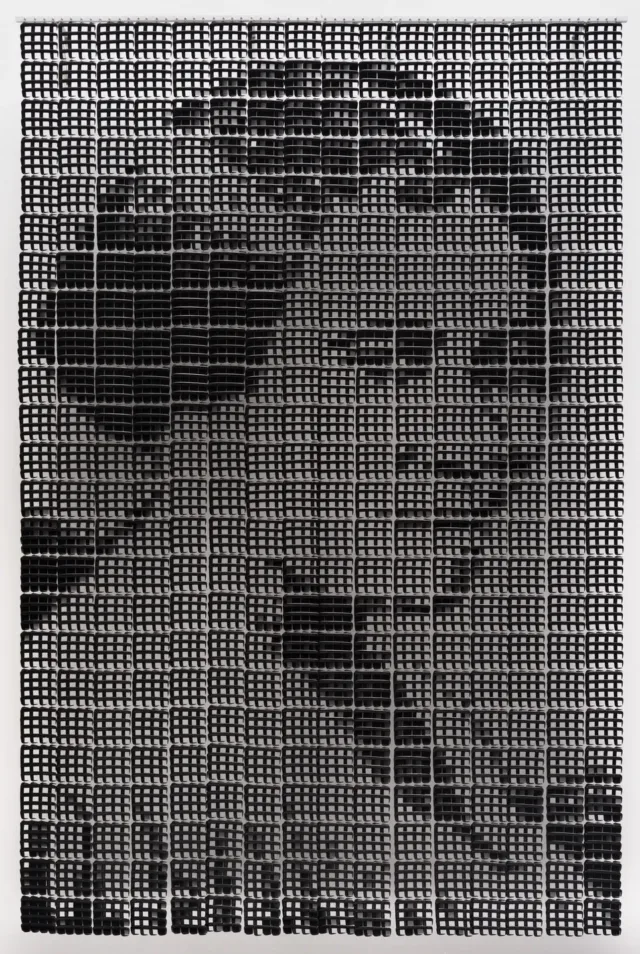
Sonya Clark, Madam C. J. Walker, 2008; Plastic combs, 122 x 87 in.; Blanton Museum of Art, University of Texas at Austin, Purchase through the generosity of Marilyn D. Johnson; Beverly Dale; Buckingham Foundation, Inc.; Jeanne and Michael Klein; Fredericka and David Middleton; H-E-B; Joseph and Tam Hawkins; Carmel and Gregory Fenves; The National Council of Negro Women (Austin Section); Lone Star (TX) Chapter of The Links, Incorporated; Town Lake (TX) Chapter of The Links, Incorporated; National Society of Black Engineers-Austin Professionals; Greater Austin Black Chamber of Commerce; National Black MBA Association Austin Chapter; and other donors; © Sonya Clark; Image courtesy of Blanton Museum of Art
In this collective work, Clark partnered with eleven hairstylists working in Richmond, Virginia. Observing that hairdressers, who work with hair fibers, are also textile artists, Clark invited each of them to create a style for her own hair. The photographs show the back of Clark’s head as well as the hairdresser who created each design. “I became a walking art gallery of their hairstyles,” Clark recalls.
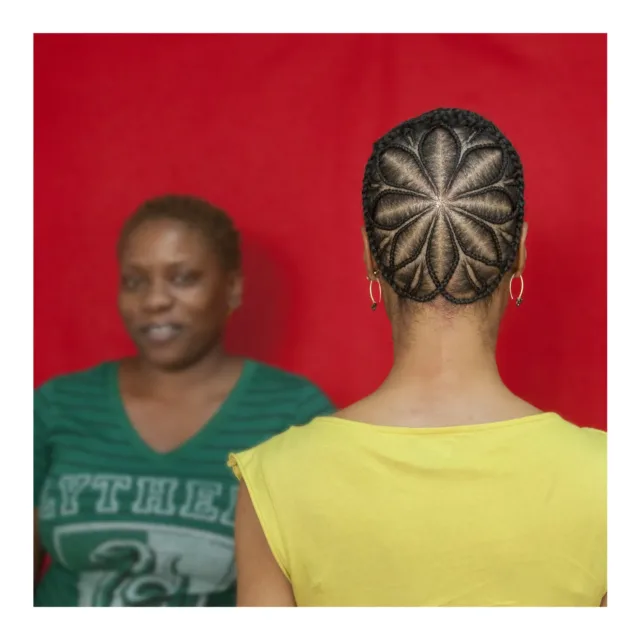
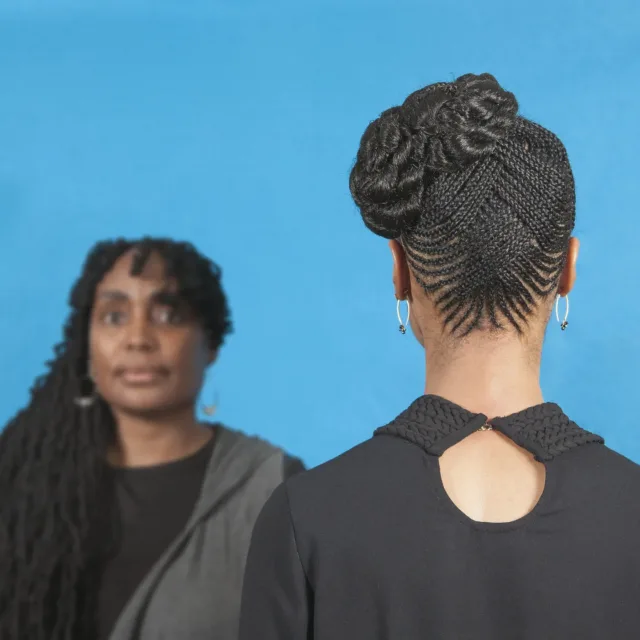
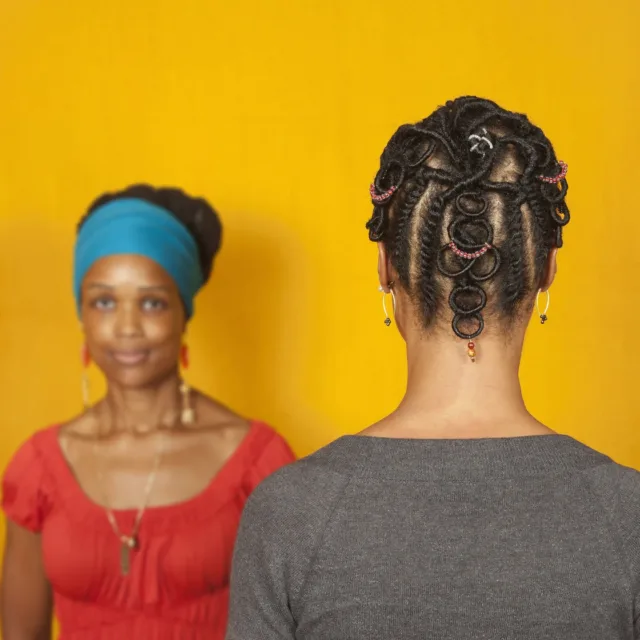
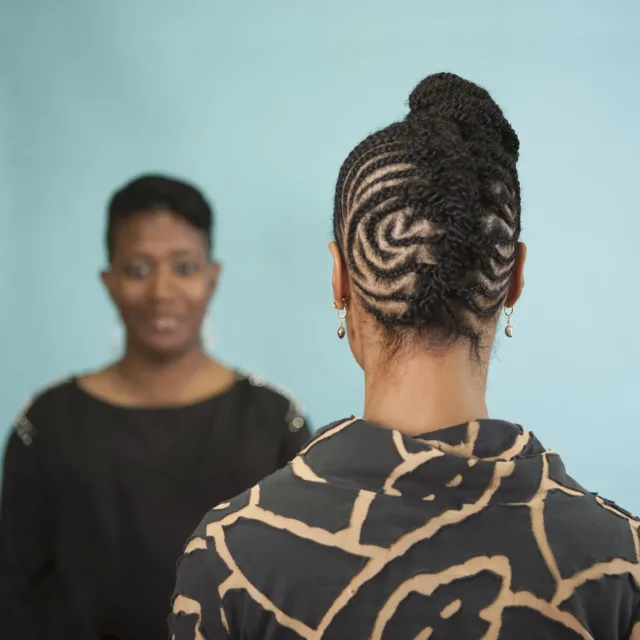
Left to right and top to bottom: Sonya Clark, Hair Craft Project Hairstyles (Jamilah Williams), Hair Craft Project Hairstyles (Dionne James Eggleston), Hair Craft Project Hairstyles (Ife Robinson), and Hair Craft Project Hairstyles (Natasha Superville), 2014; From series of eleven color photographs, each 28 x 28 in.; On loan from the artist; © Sonya Clark; Photos by Naoko Wowsugi
Clark builds many of her larger pieces by fastening together hundreds of small, black, plastic pocket combs. “When I started working with the tools of hairdressing, the tool that I picked is the most ubiquitous, the most common, the most well-known, the most average of combs,” she says. Combining these instruments on a monumental scale, Clark constructs colossal, cascading curls that hang in tight coils. These towering tendrils come to life from a tool that cannot tame them.
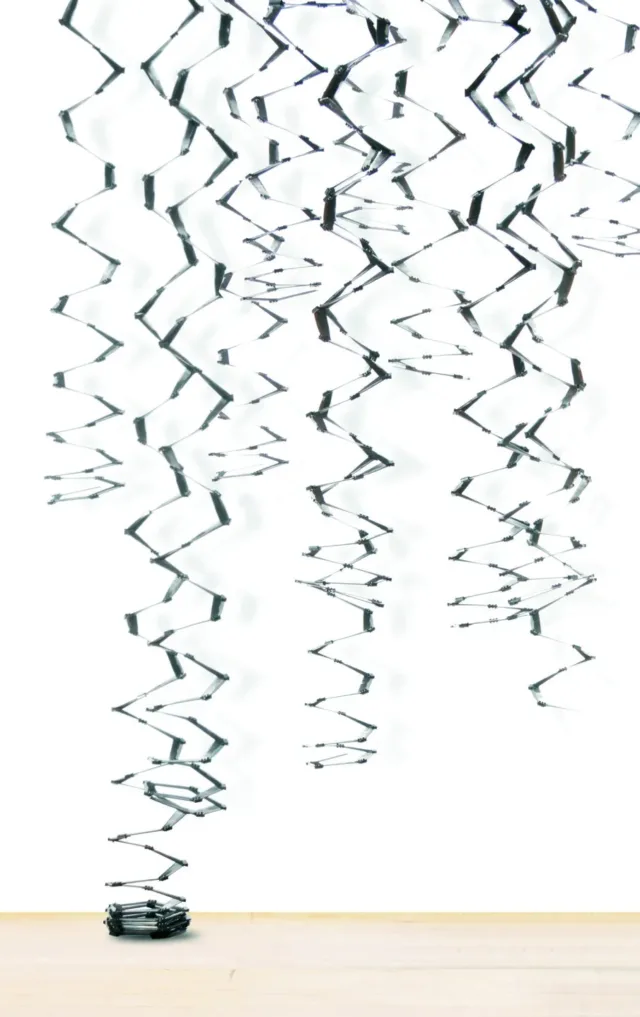
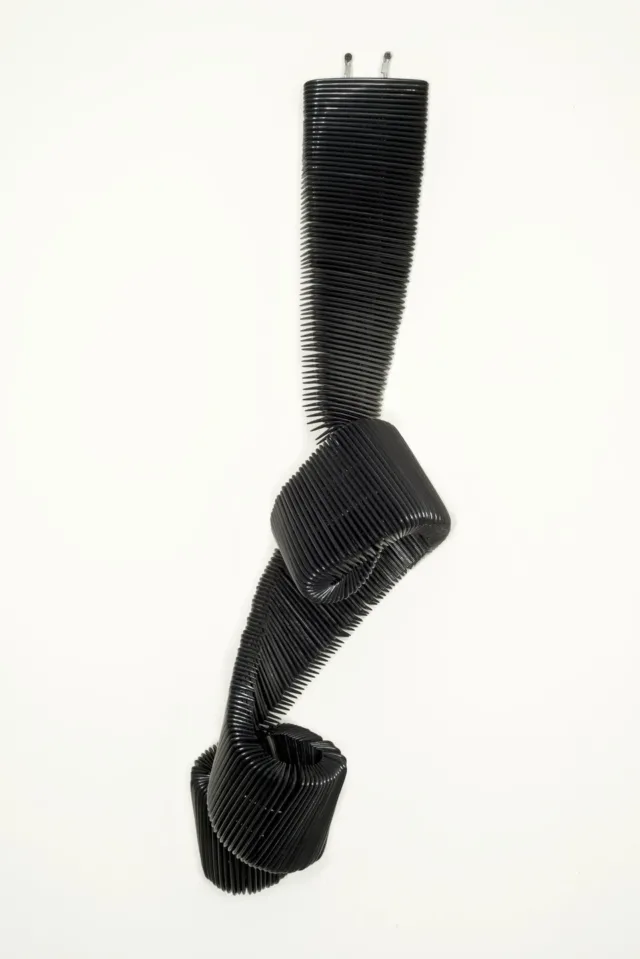
Top: Sonya Clark, Curls, 2005; Plastic combs, 96 x 36 x 36 in.; On loan from the artist; © Sonya Clark; Photo by Taylor Dabney; Bottom: Sonya Clark, Lexie’s Curl, 2008; Plastic combs, 30 x 10 x 5 in.; National Museum of Women in the Arts, Gift of Heather and Tony Podesta Collection; © Sonya Clark; Photo by Lee Stalsworth
Clark sometimes applies a reductive sculpting technique to combs, snipping away teeth to make new forms and shapes. To create Toothless, the artist tied together hundreds of plastic combs, evoking a tapestry. As the combs descend, they lose more teeth, and the remains pool below, drawing more attention to what is missing than what remains. “The word ‘comb’ has roots connecting it to the word ‘teeth,’” the artist says. “The work, in that sense, attempts to bite back.”
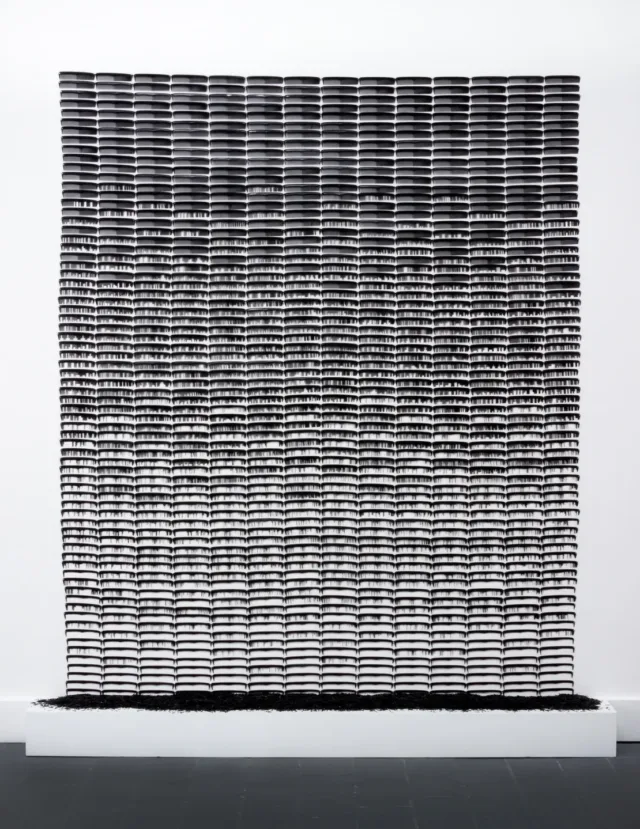
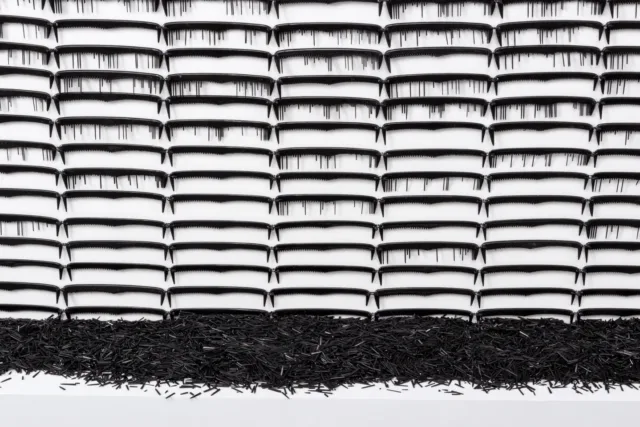
Top to bottom: Sonya Clark, Toothless (and detail), 2014; Plastic combs and zip ties, 75 x 65 x 8 in.; Collection of Pamela K. and William A. Royall, Jr.; © Sonya Clark; Photos by Taylor Dabney
One of the earliest works presented in this exhibition, this sculpture embodies Clark’s longstanding observation that visibility empowers the Black community. The word “breathe” resonates powerfully in contemporary culture, recalling the police killings of George Floyd, Eric Garner, and many others. The evocative word is also the title of a recently published book by scholar Imani Perry, whose writing Clark admires.
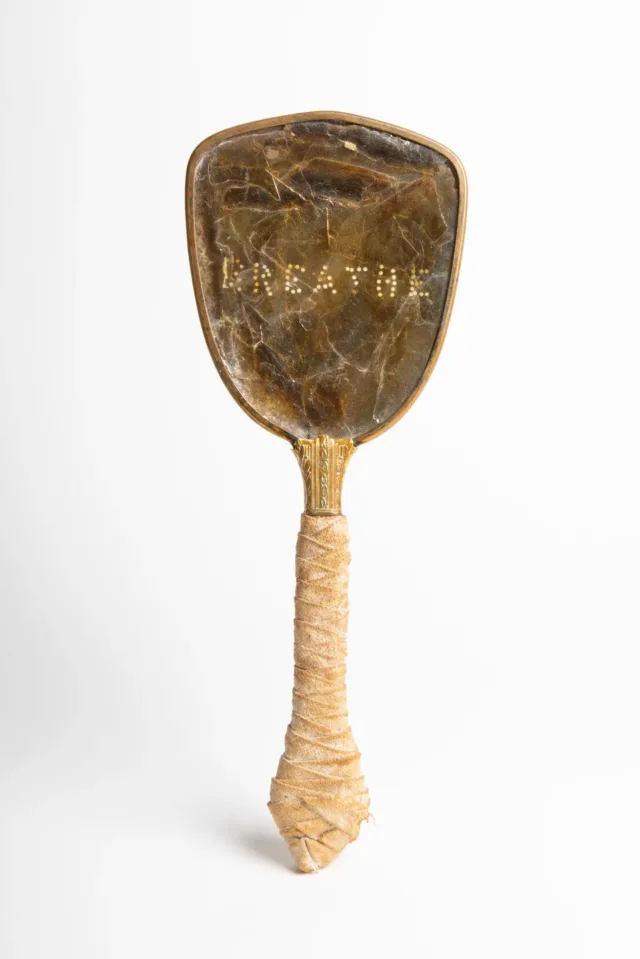
Sonya Clark, BREATHE, 1994; Found hand mirror and mica, 13 x 5 x 1 in.; Collection of Rita Grendze; © Sonya Clark; Photo by AndrewYoungPhotography.com
Sonya Clark: Tatter, Bristle, and Mend is organized by the National Museum of Women in the Arts. The exhibition is made possible by The Coby Foundation, Ltd., with additional funding provided by Share Fund, Clara M. Lovett, the Sue J. Henry and Carter G. Phillips Exhibition Fund, Stephanie Sale, and the Lenore G. Tawney Foundation.
![]()
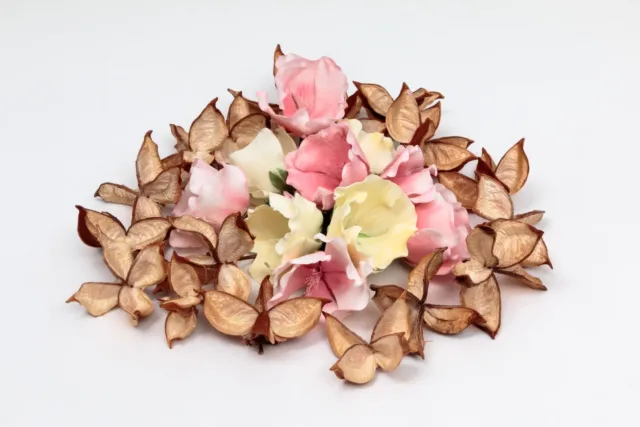
Sonya Clark, Cotton Candy Flower, 2016; Sugar and cotton pods, 3 x 10 x 10 in.; On loan from the artist; © Sonya Clark; Photo by Taylor Dabney
